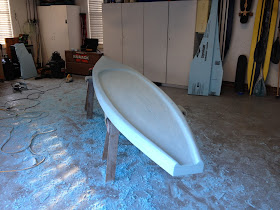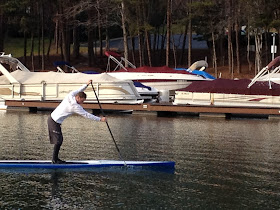This is a celebration of shapers....pros and amateurs alike....in all board sports.
Our buddy Matt decided to shape his own SUP race board recently. He has a carpentry and surfing background, hails from southern California, and has been SUP racing about as long as I have.
I'm very fascinated and impressed by folks who do board shaping. Definitely looks like more of an art than a science. I don't have the patience to do it myself but enjoy seeing how other people do it, including DW's builds. Watching my dad build sailboats over the years, including the last one that took him three years to build, gave me a whole new appreciation for the patience and skills it takes to take an idea and turn it into something that performs on the water. In my many years of windsurfing and SUP experience, I've formed opinions on various board characteristics like the length, width, tail shape, rocker, etc. So I could tell someone what kind of board I'd want shaped. Joe Bark and I collaborated on the race board he shaped for me based on my SUP skills, experience, the conditions I would be paddling and racing in, and certain characteristics I really wanted. Just don't get me in the shaping room to do it myself.
This is Matt's first board and he's already talking about how he would change the next one based on his learning experience with this one. That's what good board shapers do - trial and error, lots of testing, and back to the shaping room for changes and improvements. I can't wait to see what Matt comes up with next.
The following is the sequence of photos sprinkled with some of Matt's comments as he sent them to me between late October and early January, culminating with the Cold Stroke Classic race on January 19th on this board.
Matt: "I still have to change the tail and may shave off the "cheekbones" I intentionally placed just forward of footwell. Getting close to be ready for glass."
Matt: "Thank goodness for 2 sons. I laminated the glass coat on the top of the board today and if not for the boys I would have jacked up all my hard work. 14' of board with concave deck is probably not a good idea for a 1st time attempt at glassing. The bottom I did by myself(another poor idea). If I didn't have Nick to mix and pour epoxy and Andrew to help spread it would have gotten ugly. And that is in a garage in mid 60's. Too cold for a real glasser. Tomorrow the hot coat and hope to get gloss coat on by Christmas day."
Matt: "I did make a major design error on amount of glass layers. The board is
34 lbs (good) but it has much more flex than I anticipated. It will be a
great flat water board but after trial run today I will be hesitant to
take it in rough conditions."
Matt: "She paddles really smooth. The bow was designed to cut the water and also to help track straight since it is so square it is always in contact with water. In that respect it did exactly what I had planned. It tracks really straight. Definitely much better glide than the 12-6 Hobie. But the problem is the flex. I only placed one layer of 6 oz E cloth on each side with one extra layer for deck patch. It feels a little bit like a trampoline if you bounce on it. When just paddling as hard as you can on flat water it is not an issue. But very concerned for when conditions are rough and choppy. I don't know if it will just flex and not break or......... Overall very pleased with everything. It rides low in the water because it is only 4-3/4 thick at thickest section and tapers thinner to rear. Would definitely make changes if I was going to do it again. But hindsight is 20-20. I only had $735 in materials invested so nothing to cry about."
I'd love to hear more stories from others about the very first board they ever shaped and the lessons they learned over time as they continued to shape.
If anyone out there has any comments, suggestions, or questions for Matt, leave them here and I'll help get them answered or he'll answer you directly here.







































My suggestions:
ReplyDelete1) Laminate on a table. It will save tons of weight and it's much, much easier. You might as well learn the composites builder way. http://www2.swaylocks.com/forums/try-laminating-table
2) You have to use carbon fiber with 1 lb foam. Once my lam skills improved, I switched to full carbon. Carbon's a bit expensive to learn with.
3) The hardest part, is just holding your rocker during lamination. 1 lb foam bends under the weight of cloth and resin.
4) Us only Greenroom Epoxy. Way better. Idiot proof and cheaper.
5) Get half slow, half faster hardener from the Greenroom with your resin order. This will let you slow things down just right for first timers. Order from David at the Greenroom.
Can't figure out what the blue stuff is in the photos.
6) Foam is cheapest from the boat dock foam suppliers. In Wrightsville Beach, we get it from the hardware store. 16' x 24" x 24" is only about $70.
Hit me up direct for any more help.
thanks for the input. I've seen some of your work on your blog and it's very impressive. a little clarification though:
ReplyDelete2) I just used fiberglass E cloth from foam-ez--no carbon fiber on this 1st attempt
3) I built an extra sawhorse to place in center and put leg extensions on all 3, then I just adjusted center one to maintain camber(rocker). I actually could have changed rocker at this stage by raising or lowering the height of sawhorse. I stuck with my very flat 1-1/4" end to end
5) The blue stuff is shavings from the Dow XPS 2 lb insulation that I made the blank from. I glued up 2" layers of this material with epoxy--it was left over on my construction site so I thought why not? I could not find a place to buy a foam blank---(now I know) I think if i had just doubled up on fiberglass the board would have been much stiffer and it would not have added as much weight as I thought it would have--oh well, next time!
Hey there.
ReplyDeleteThanks for the post. The pics are great and your board looks amazing! I am building my first SUP and so far it's been a fun project. I found a foam supplier in my area (Portland,Or) and was able to get a pc of scrap 2lb foam 10'x32"x6" for $50. My idea is pretty original as far as I can tell. I wanted to build a SUP with a shaped hull similar to my kayak and not install a fin. I put the glass on the bottom 2 days ago. Should be ready to glass the deck after one more day. My biggest issue has been dealing with the tearing of the EPS foam when sanding. I had to use quite a bit of microsphere filler on the deck and hull to prep the surfaces for glossing....I wonder what tools real shapers are using?